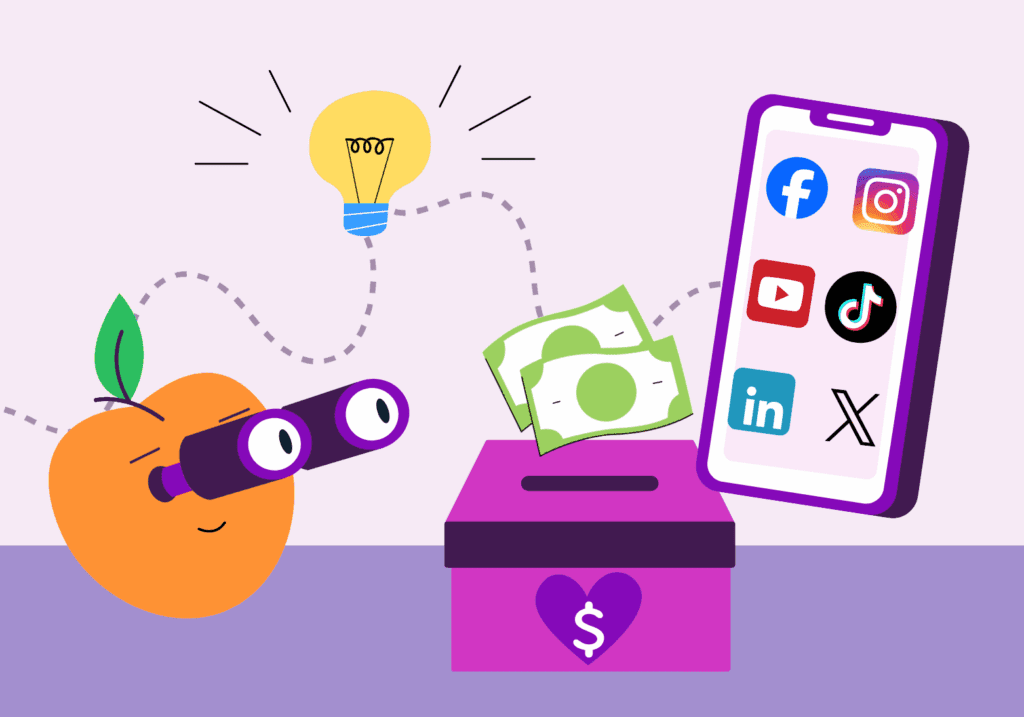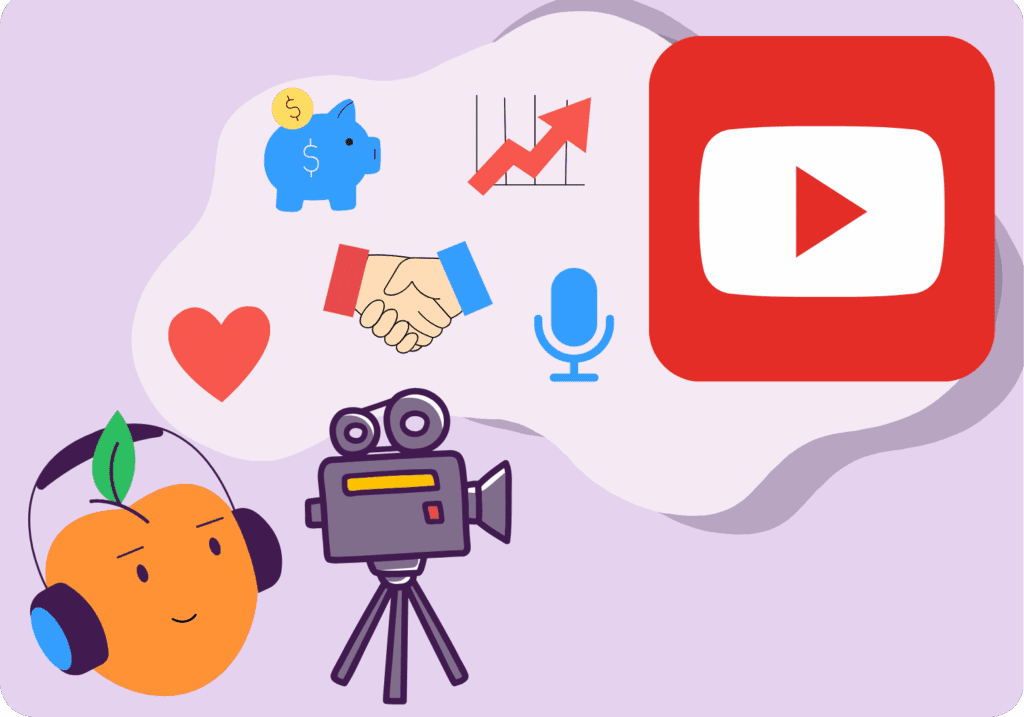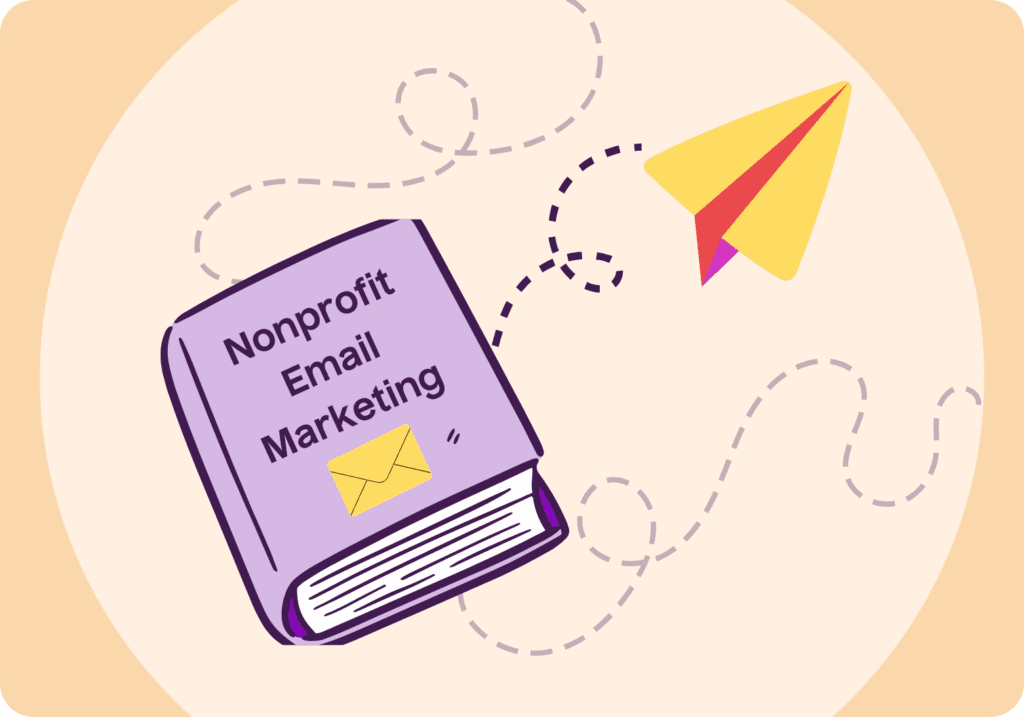There are a lot of ways your organization can promote the great activities you’re doing while engaging your volunteers and members.
You can do this with technology like texts and social media or stick to the classics like snail mail and weekly meetings.
So how do you pick which one is right for you?
Most nonprofits have found that the easiest and most effective way to communicate with your supporters, volunteers and members is the email newsletter. But how can you optimize it and make sure you’re creating a newsletter that gives your people what they want while being engaging, informative and hopefully, driving people to your website.
Read on to find out how to master the nonprofit newsletter and check out some amazing examples to get you inspired!
Why a Nonprofit Newsletter Might be the Right Promotional Channel For You
When you keep your subscribers in the loop, it keeps your mission in the front of their mind. By providing timely content and organizational updates, a newsletter is a perfect way to keep your organization’s followers updated about all the great work you’re doing.
Your newsletter is central to giving your subscribers timely updates about how you’re developing your mission and operations — updates that can help them feel more involved and engaged with everything you’re doing.
Let’s start with the important steps to creating an effective newsletter, then we’ll share a few examples of great nonprofit newsletters and what you can learn from them.
6 Key Steps to an Amazing Nonprofit Newsletter
From your newsletter’s content to how often it’s sent, every aspect of a nonprofit newsletter can be customized to best appeal to your readers.
To help you get started, or just to give you a quick refresher, here are some best practices to keep in mind as you’re building your newsletters.
1. Figure Out Your Objective
If you haven’t articulated your newsletter’s goals recently (e.g., in a yearly communications/marketing plan), it might be time to re-establish and prioritize your list of objectives.
For example, is your key goal to keep members, volunteers or donors informed about your organization’s news, activities and accomplishments? Or is your newsletter your main form of promotion for regular events or activities – for which you want/need them to take action (e.g., register/volunteer/donate)? Setting clear objectives will help steer your decisions on scheduling, layout and content.
2. Get to Know Your Audience
It may sound obvious, but having a thorough understanding of what your members/readers want helps enormously when creating content for your newsletter. If your content isn’t immediately relevant and valuable to your members or prospects, you run the risk of not getting your message across.
Some practical thinking from your board and leaders should be able to generate some general ideas on what your readers would be interested in. Think about why they joined your organization, what they expect from you, and what they may find useful.
If you find difficulty in figuring out what your audience wants, just ask them! A simple survey passed around at an event, or sent out via an email can get you all the answers you need. Use the conclusions you arrive at to shape any piece of communication.
3. Plan Out Your Content
Your newsletter is a great vehicle for nurturing your relationship with your members, supporters, and volunteers.
While the subject matter will depend on your organization’s scope or mission as well as your communications objectives, here are some guidelines you might want to consider when developing your newsletter/email content:
Get Their Attention
First impressions DO COUNT when it comes to your email subject line and newsletter headlines. You’ve heard it all before – you need to offer interesting and intriguing subject lines to get your email opened. This doesn’t mean being too clever or controversial – since the title needs to be linked to your newsletter topic or lead story to let the reader know what to expect.
How Much Content?
The nature of an e-newsletter dictates brevity. Many e-newsletters offer three to five brief overview paragraphs with links to the rest of the article through a “read more” link back to your web site. This is an effective way to drive traffic to your web site. Alternately, you can include short articles and updates and refer readers to other areas of your website for more detail.
Be Genuine
Your e-newsletter is not the Wall Street Journal! While you need to write tight and concise copy, your readers are subscribing to, and hopefully reading, this newsletter for a reason, so be sure your organization’s unique culture or voice isn’t sacrificed through attempts to sound professional. On the other hand, be sure you don’t lay the industry jargon on too thick. Try to find a balance – with a clean crisp writing style that also suits your organization’s style or persona.
Have a Call to Action
Every newsletter should have a call to action. To make the most of your newsletter, try getting across to your recipient a clear idea of what to do next. Whether you want them to click on a link, engage with you on social media or buy a ticket, keep your call to action brief and straightforward. An effective call to action is between two to five words. However, whatever the desired action, it is important you create some urgency around it. So try using some active language. For example if you want your recipient to donate money, “Donate Now” would be effective. If you want them to follow you on Twitter, “Follow us on Twitter” works.
Mix Up Your Content
While your newsletter should encourage your nonprofit’s overarching purpose and possibly encourage donations, you should be sure to mix in opportunities for subscribers to be informed about other types of company updates as well to make sure they are familiarized with what you are actually working on. Keeping your subscribers in the loop about what your nonprofit has been up to increases their awareness of your mission, and strengthens the identity of your organization in the minds of your readers. It also maintains a steady stream of opportunities for them to think about getting further involved with your nonprofit.
Build Relationships
You know just how essential building relationships with potential donors is to your mission — and a newsletter can help with that too. No one likes getting emails that are all about selling them something. Instead, you can include a question at the end of the emails to get readers to respond, or feature stories of your nonprofit’s beneficiaries, rather than telling everything from your own perspective. Leveraging personal, direct copywriting is not only beneficial for gaining interest in your newsletter, but is almost essential for your nonprofit to acquire the money and support it needs to thrive.
4. What to Consider for Design
I know all too well that non-profits and member-based organizations need to ensure that their communications don’t appear too expensive so they aren’t perceived as using funds that should be applied to serving the organization’s mission.
This means you need to strive for a happy medium between a slick or too-sophisticated design and one that is too dull, old-school or homespun. If you have someone develop a good, clean layout format that incorporates your organization’s logo and design standards, it should help with readability while also projecting an image of cost-effectiveness.
The first thing to remember is that an e-newsletter is not a print newsletter – they are different media. People read emails and online material very differently than they do print versions. If you are lucky enough to have them open your email, you are likely going to have to deal with a short attention span and high expectations. People usually scan an email, so it is extremely important that you follow a few online design techniques, including:
Capture the reader’s attention with a focal point:
This might be through a high impact header or masthead; a bold headline or a photo that draws the reader’s eye to the lead story. Don’t forget to make it clear whose newsletter this is – e.g., have your logo and organization name clearly visible if it isn’t part of the masthead.
Offer a clean, crisp design:
- Keep it simple: the eye gets confused if there is too much going on – e.g., too many photos or visuals or a busy layout without any white space.
- Use colour effectively & boldly (for more tips, check out our post on nonprofit branding)
- Don’t use too many fonts or typefaces and be sure body text is readable (especially if your audience is over 40)
Guide your reader through:
- Offer a table of content
- Break up the content:
5. Stay Top of Mind… Without Spamming
Once you’ve built your email list, it’s your job, as the one producing the newsletter, to make sure you’re sharing information with your loyal subscribers consistently. Depending on how involved they are with your organization, you can decide how often you’ll be sending out your newsletter. Each email reminds your subscribers about your organization and brings your mission to the front of their minds, if only for a few seconds when they see the email in their inbox before even clicking into it.
Consider which day and time are best for sending your e-newsletter. The quick answer is – it depends on your audience. For example, the majority of business-related emails are opened between 5 a.m. and 5 p.m., Tuesday through Thursday – with 11 am being a suggested sweet spot. But your recipients may want to read your e-newsletter at home or on the weekend, depending on your content and their profile (e.g., men, women, students, type of career, etc.). Of course, scheduling may also need to coincide with event or program timelines if you are looking for time-sensitive registrations, program commitments or donations.
Once you claim a constant presence in the inboxes of your subscribers on a recurring basis, you’ll be able to move forward with maximizing the potential of your newsletter. They’ll come to expect information from your organization to populate at certain times and — if you’re doing it right — even be excited to receive your consistent updates!
6. Analyze Your Results
One of the strengths of electronic messaging is that it offers analytics. Most email platforms (including WildApricot) automatically produce some or all of the following data:
- Open rates
- Reports on who clicked on links in your newsletter (e.g., links to your website)
- Subscription information – e.g., unsubscribe and new subscriptions
Track this data when sending your newsletters at different times and days of the week to uncover what is the most effective day and time for your organization and audience, as well as which types of content are the most engaging.
8 Nonprofit Newsletters to Keep You Inspired
While there are many examples of amazing email newsletters, here are a few from nonprofits large and small to get you motivated as you start creating yours!
1. Save the Manatee Club
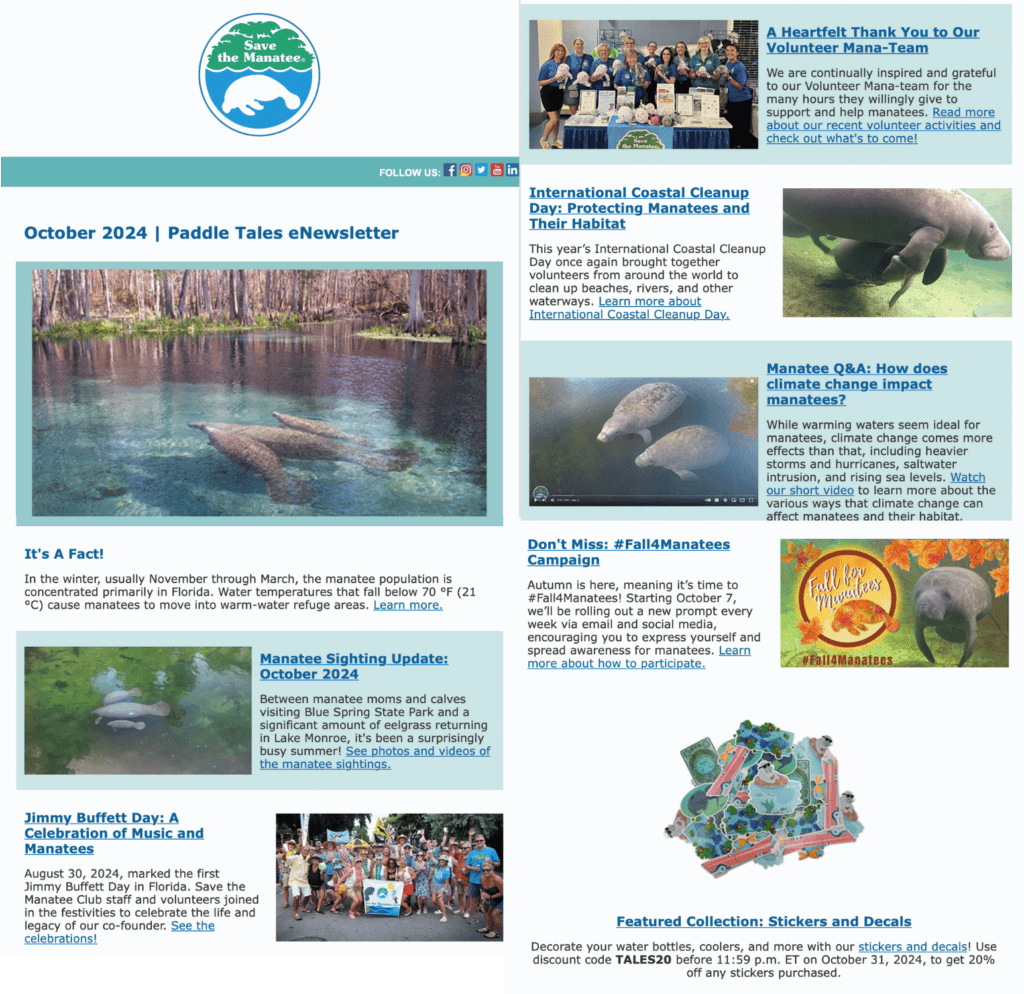
Save the Manatee Club‘s newsletter has a combination of great features that make them stand out. The e-newsletter, “Paddle Tales,” has a name no one could forget. It’s a play on words for the manatee’s paddle-shaped tail and the great content, or tales, you’ll find inside. Additionally, they utilize featured images of adorable manatees that catch the eye, and a wide variety of stories that the reader can check out.
How You Can Do The Same: Brainstorm with your team how you can highlight your nonprofit’s cause through the name of your newsletter. Think of associated words, phrases or homophones to make it stand out! Share content from your nonprofit’s blog and other relevant stories to get your subscribers clicking back to your website. This way, they can build a deeper connection with your content.
2. Dorothea Dix Park Conservancy

Dix Park Conservancy keeps their newsletter short and sweet, focusing on their newest initiatives, events and improvements to accessibility. In each section, they call the reader to come to the park and contribute to building community with their blue CTA buttons. The conservancy also highlights their donors through the community spotlight, showing subscribers the impact they make.
How You Can Do The Same: Engaging your subscribers is key for a successful newsletter. Give your readers multiple ways they can get involved with your nonprofit, whether it’s an upcoming special event or donating to your next project. Use clear call-to-action (CTA) buttons that stand out and link to your nonprofit’s website.
3. NPR
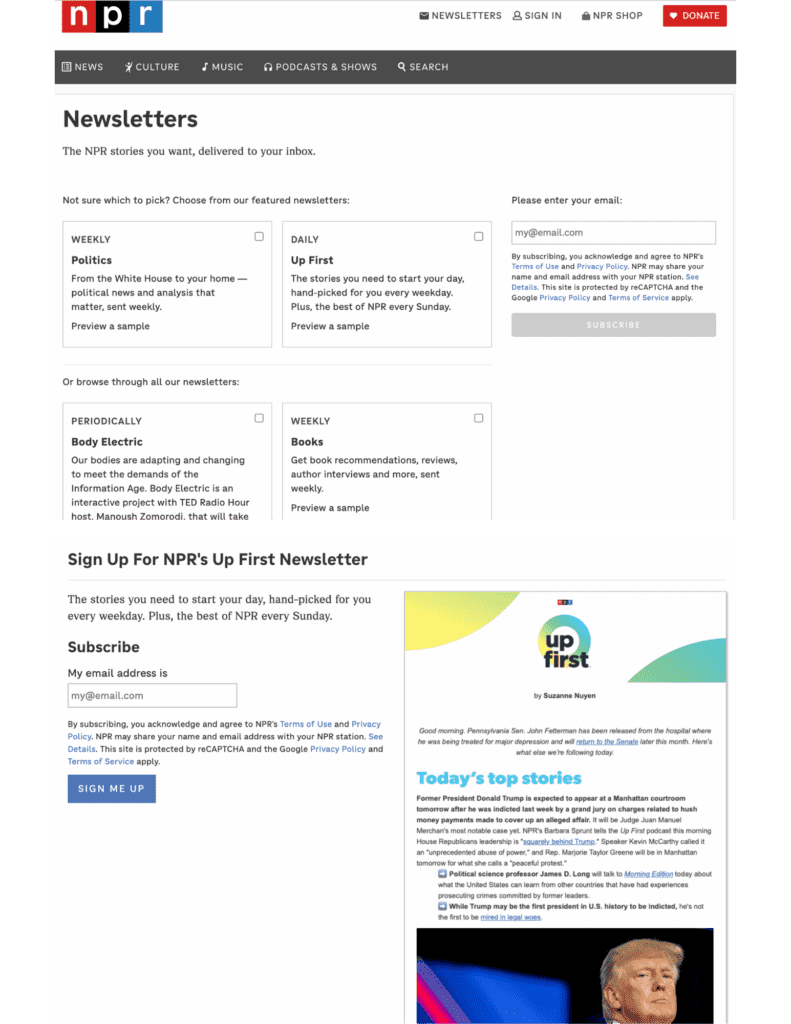
NPR has a variety of newsletters to subscribe to depending on the recipient’s interests. When subscribing to their newsletters, NPR gives a brief description, a sample newsletter and the frequency. They even make it easy by listing their options with check boxes – so you can subscribe to multiple at once. Separating email content like this lets the subscriber be in charge, selecting as many or as few newsletters.
How You Can Do The Same: If your nonprofit puts out a wide variety of content or you find yourself sending newsletters too often due to your organization’s updates, split them up! Your nonprofit could offer newsletters focused on topics like fundraising, events, volunteering and community impact. This can be done retroactively too by segmenting your email lists with a “update your preferences” email to subscribers.
4. Edesia

This newsletter from Edesia begins with a powerful photo and goes on to tell the story of the girl in the photo and how the organization was able to help her and thousands of children like her. The letter also mentions and links to a video that showcases their work in action.
How You Can Do The Same: Include personal stories in your newsletter as much as possible — they can be a powerful way to establish an emotional connection with the reader and inspire them to take action. If possible, compliment the stories with photos and video footage. The video that Edesia sent in this newsletter was a 30 second cellphone video from someone who was helping load boxes of nutritional bars onto a truck in Sudan. This is a great reminder that your videos don’t have to cost thousands of dollars to produce to have impact — something as simple as a cellphone video straight from the front lines can be just as, if not more, powerful.
5. Goathouse Refuge


The Goathouse Refuge puts out quite the monthly newsletter to their subscribers, this is just a portion of it! They provide powerful stories on adoptable cats, relevant articles or fun facts applicable to the season, requests for volunteers and updates on any fundraising campaigns. All of this is complemented by plenty of pictures of cats, grabbing the attention of subscribers and appealing to the target audience: animal lovers!
How You Can Do The Same: Keep your mission at the focus of your newsletter, everything said in the email should support your cause or educate more about it. This applies to your visuals and the pieces of content you share. It wouldn’t make sense to give recycling tips to subscribers of an animal rescue organization!
6. American Red Cross – Tiffany Circle
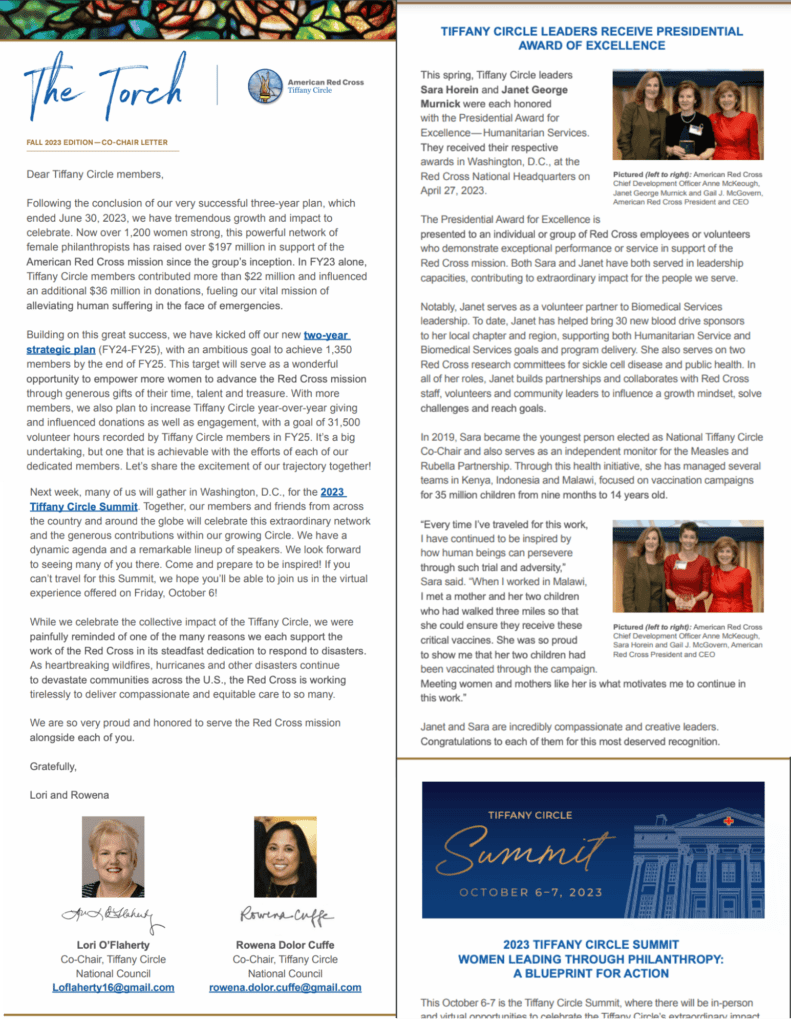
This American Red Cross newsletter starts off with a message from the co-chairs, adding a personal touch to a newsletter from a large organization. It reviews all of the work that the nonprofit has accomplished in the past year and sets goals to accomplish in the next year. This newsletter does a good job of making the reader feel like they are an essential part of Red Cross’ mission and achievements, as well as sharing accomplishments of members and upcoming events.
How You Can Do The Same: Include a brief section within your newsletter that covers what goals you’ve accomplished and what you’re working on. This doesn’t have to come up every time, but including it occasionally will remind readers of the many things you’re doing to help your community.
7. Habitat for Humanity
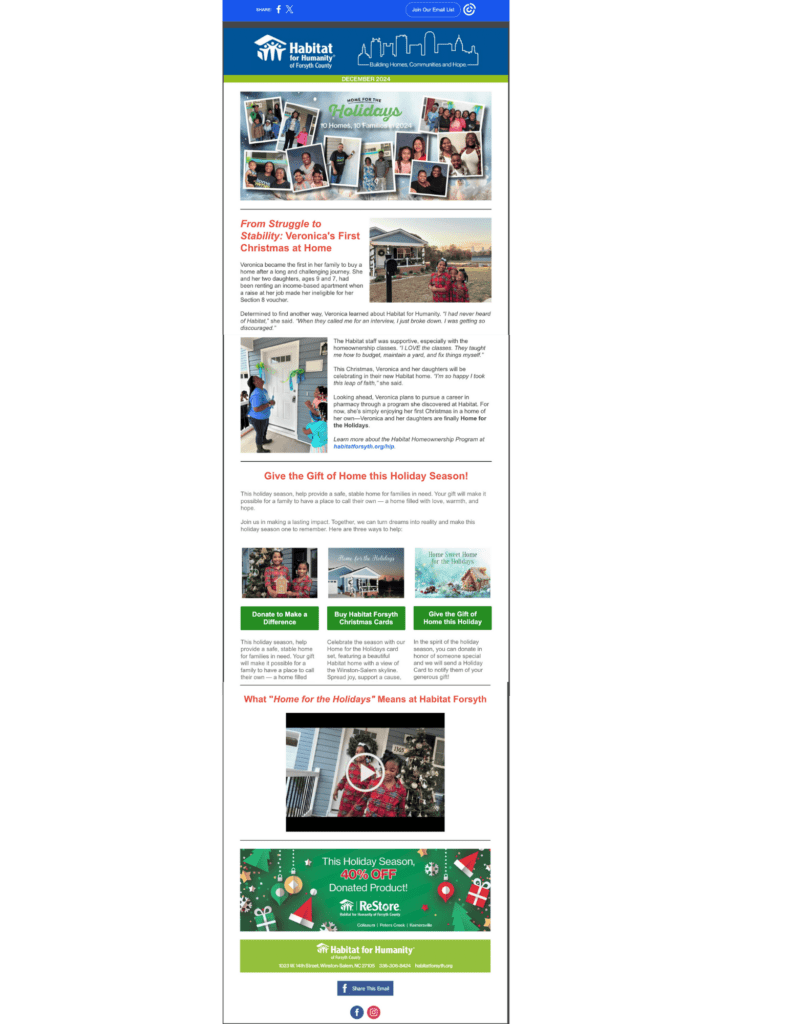
This Habitat for Humanity newsletter from the organization’s Forsyth County chapter checks off all of the boxes for what makes a successful nonprofit newsletter. It has links to all of the organization’s social media accounts at the top of the newsletter to encourage further engagement and encourages sharing at the end. It lists recent organization achievements, an impact story with photos and offers multiple ways that recipients can be further involved with the organization. A simple design helps make all of this information readable and easily processed.
How You Can Do The Same: Don’t worry about including a fancy design in your newsletter. It can be minimal as long as the content is all valuable and relevant to your subscribers.
8. No Kid Hungry

This newsletter from No Kid Hungry is all about the valuable content for the subscribers. Regardless of the way someones likes to consume information, this email provides a resource for them (video, live webinar, article, etc.). They close out the newsletter with a closing question to encourage participation from the reader. This allows them to build a better community and continue the conversation on healthy eating habits for students.
How You Can Do The Same: Look to the experts in your nonprofit industry for resources your subscribers would find valuable. There’s not always time or staff to create new content, so compiling blogs, e-books, upcoming webinars and more will keep your newsletter relevant and out of the trash or junk folder.
Ready to get sending?
As a nonprofit, you’re looking for ways to get frequent updates and promotions related to your organization out to as many people as possible — without having to spend too much time on it.
That’s why an email newsletter can be a great way to drive further engagement with your organization. Through it, you can communicate recent news updates, remind readers about the purpose your organization serves, and encourage further engagement.
If you don’t already have a platform for sending emails, consider WildApricot’s email editor. You can easily customize your newsletters as much as you’d like, or use one of WildApricot’s pre-built templates. If you already have a WildApricot plan, you will be able to seamlessly send automatic or manual emails to your existing contacts. If you’re not yet using WildApricot, you can start a free 60 day trial and try out the email editor for yourself.



